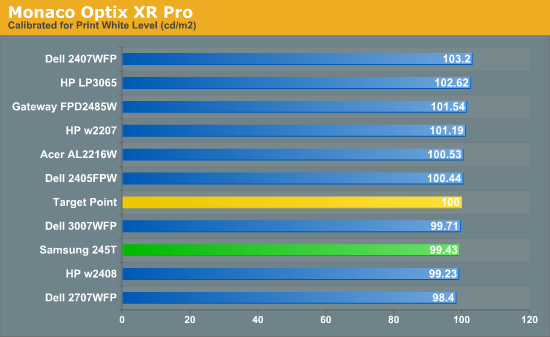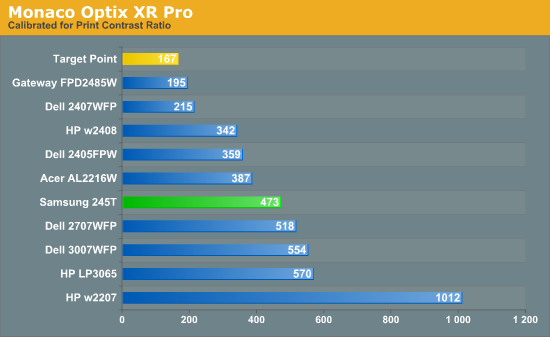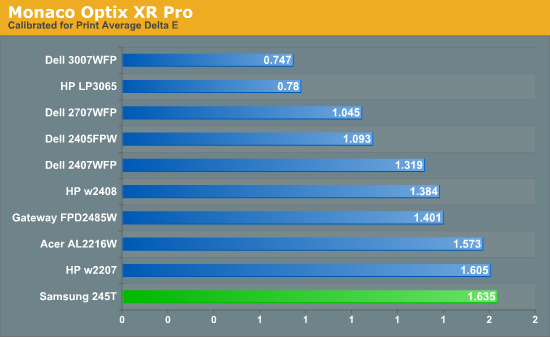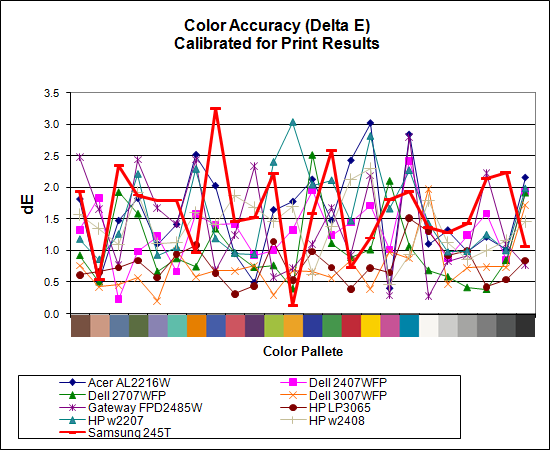Printing
Results
Brightness and Contrast Ratio
For those who have a need to match colors between their computer displays, cameras, and printers, what works well for computing purposes often isn't the best suited for doing other image related work. To help people who work in such areas match their computer colors to their paper colors better, standards were established. For print work, the standard is a gamma of 2.2, a black point of 0.60 nits, and a white point of 100 nits. We attempt to calibrate all the monitors for these settings.
Finding the appropriate settings to reach these levels can be a time-consuming process for some of the displays. It may require numerous iterations through the calibration process to end up with the desired white point, and on some LCDs it might not even be possible to reach a satisfactory result (though that hasn't occurred yet). The nature of LCDs is such that we are unable to get both an accurate white point and an accurate black point according to printing requirements (our black levels always ended up darker than they are supposed to be), but we did manage to get near the desired 100 nits white point on all of the tested displays. For the Samsung 245T, we used brightness/contrast settings of 13/75, with RGB at 16/21/36. We tried several other settings, but all others scored worse so we settled on these values.
For reference, we have included the target value in the following graphs, so the greater the deviance of a display from the targeted value, the less suitable (in theory) a display becomes for print work.



Since very slight differences in brightness are not a huge deal, we did not attempt to get 100% accuracy on the white point, but further tuning of the various displays would have made it possible to get closer to 100 nits. The primary goal was to get the white point near 100 nits. The target black point is impossible to achieve once we have reached the target white point with any LCD that we have tested to date - and we expect that trend to continue. Due to the reduced brightness, contrast ratios are often lower, but that is inherent with the target settings. The Samsung 245T is pretty average when it comes to "calibrate for print" brightness and contrast ratio.
Color Accuracy
Given the importance of accurate colors for printing work, we need to adjust the desired Delta E scale. A Delta E of less than 1.0 is definitely the goal here, and 1.0 to 2.0 is merely acceptable. Scores above 2.0 generally mean a display is not fit for printing professionals.


At the reduced brightness setting used in this test, the Samsung 245T doesn't score as well as it does in other areas. In fact, it's technically the worst LCD we've tested so far -- at least in terms of raw score -- when it comes to calibrating the display for print work. Considering that all of the displays do reasonably well in this test, however, this probably isn't a big enough concern that we would strongly recommend a different display, other than one of the 30" LCDs on the market. Whether it's their use of S-IPS panels or something else, we can't say, but the 30" LCDs that we've tested have the lowest Delta E scores of any of the monitors.










60 Comments
View All Comments
daarrid - Wednesday, August 13, 2008 - link
First, I'd like to thank Jarred Walton for his excellent review. A great deal of work goes into such a review. So, first and foremost, thank you sir! I'm also impressed by your timely follow-ups to the comments that have been posted.I just purchased the Samsung 245T (August, 2008). The firmware evidently has changed because there are new scaling options.
I'm only using two inputs - the VGA for various computers connected to it via a KVM and a Sony Playstation via the HDMI.
The VGA input now shows three options for size: wide, 16:9 (this is new), and 4:3. Wide is the only useful option (it appears to be 1:1 pixel mapping). The other two options distort the display. Why 16:9 was added as a choice is hard to say because it adds no useful function I can think of.
However on the HDMI input (and perhaps the DVI - I didn't test the DVI input) we have the old choices - Wide, 16:9, 4:3 and a new one! The new one is called "Just Scan" which seems to be 1:1 pixel mapping. Samsung evidently is listening.
bobo51 - Thursday, June 26, 2008 - link
I find it interesting that 4 months after Jarred was reassured by his contact at Samsung that this panel was a PVA, it is still speced as a TN panel on the Samsung website. And the mail order websites that report this characteristic seem to just parrot what is on the Samsung website.It would seem that it being a PVA unit would be a marketing point that Samsung would want to be front-and-center in their specs and advertising. So why isn't it out there?
Does anyone have any written documentation or labeling on the back of a unit (or anything other than someone's statement) that this is a PVA panel?
maxdog - Friday, August 22, 2008 - link
All of the 24" panels on the Samsung website state the same type. I'd like to know for sure.TrinityJayOne - Saturday, June 7, 2008 - link
Just thought I'd point out that there's an error in this review regarding display modes. It's true that there's no 1:1 pixel-mapping, but there IS a 16:9 option, it just isn't available when using a DVI source (I'm guessing because Samsung figure DVI = PC only and video cards support 16:10 resolutions). For HDMI, component, S-video etc, the 16:9 option will keep your 1080p signal un-squished and 720p will be upscaled. Check it out for yourself in the user guide, about 2/3 of the way down the page- http://downloadcenter.samsung.com/content/EM/20070...">http://downloadcenter.samsung.com/conte.../200707/...XrayDoc - Wednesday, April 2, 2008 - link
The new Dell 2408WFP has been available for perhaps a month. When are we going to see a killer review on AnandTech?machspeed5 - Saturday, February 16, 2008 - link
Conflicting Information!!!Page 4 of this trustedreview of the 245T states "genuine 1:1 pixel mapping"
http://www.trustedreviews.com/displays/review/2007...">http://www.trustedreviews.com/displays/.../2007/11...
".....A tonne of connectivity only adds to the appeal, as does the genuine 1:1 pixel mapping from 1080p sources."
This Anadtech review clearly states the opposite!
Who is correct here? Clarification appreciated, as you've thrown a monkey wrench in my purchasing decision! :P
Thanks
machspeed5 - Saturday, February 16, 2008 - link
found this:source: http://www.hardforum.com/showthread.php?p=10319083...">http://www.hardforum.com/showthread.php?p=10319083...
According to the User's Manual:
- if the video source is connected through PC/ DVI, you will be able to switch the size between "Wide" and "4:3";
- if the video source is connected through Composite/ S-Video, you will be able to set the size to "Wide", "16:9", "Zoom1", "Zoom2" or "4:3";
- if the video source is connected trough Component/ HDMI, you will then be able to choose the size between "Wide", "16:9" or "4:3".
Supposedly, by "Wide", they mean "Full screen" (1920x1200).
I don't really know what they mean by "Zoom1" and "Zoom2", but I guess this is some scale of "expansion" (by keeping the aspect ratio). But I insist, this is just me guessing; I do not own the screen.
As matter of fact, this leads also to the conclusion that there is no pure "1:1 pixel mapping" for all resolutions, even if you can get such pixel map for a HD 1080 lines source if you choose the "16:9" size.
can you confirm please, & perhaps update the review? many thanks.
JarredWalton - Saturday, February 16, 2008 - link
I checked the VGA and DVI connections... I didn't consider that they would add options on other inputs (most OSD controls gray out disabled options rather than removing them completely). I'm trying to come up with some meaningful "input lag" testing -- internal image processing lag would be more appropriate as a description -- so I'll see about testing the Component/HDMI/S-Video as well.Not surprisingly, I've got other things to review as well, so it might be a couple weeks before I get around to testing this.
machspeed5 - Sunday, February 17, 2008 - link
thanks.looking forward to seeing the input lag & HDMI pixel mapping options on the 245T. :)
word on the street is that the input lag is pretty bad, ~50ms, (2.5 frame lag.)
from my readings, 50ms (while on the upper end of laggy displays) may still be usable for all but the most time-sensitive games. (fps specifically) a lot of people complain and overrate the input lag problems on forums, though it's evident few understand what it is. (even confuse it with response time)
i'd appreciate hearing your opinion on the matter. I plan to use a PS3 with the 245T, and FPS will certainly be in the machine from time to time.
Genuine 1:1 pixel mapping is also important to me, and if you could clarify the issue here i'd be much appreciated.
cheers
Thetruepit - Monday, February 11, 2008 - link
It does suffer from inverse ghosting.Most noticeable in gaming mode so I don't use that.
Surprised it wasn't picked up. Also if you move your mouse cursor over a grey background you see noticeable ghosting.